Welcome to our free classical music site

Do you write about classical music? Are you a blogger? Want to team up with Classical Connect? Send us a message, let's talk!

Do you write about classical music? Are you a blogger? Want to team up with Classical Connect? Send us a message, let's talk!
This Week in Classical Music: December 12, 2022. Beethoven. Ludwig van Beethoven was born in Bonn on the 16th of December of 1770. We wanted to celebrate Beethoven with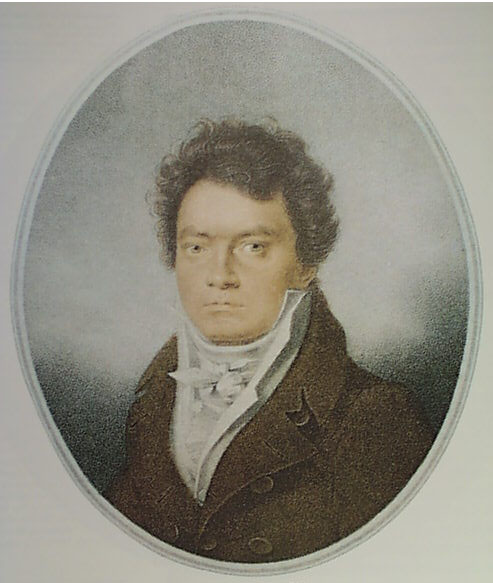 performances made by two musicians whose anniversaries we also commemorate this week, the pianist Rosalyn Tureck and the violinist Ida Haendel, but it turned out to be a more difficult task than we expected. We knew that Rosalyn Tureck, who was born in Chicago on December 14th of 1914 into a poor family of Jewish immigrants from Russia, was one of the most important interpreters of the music of Bach. So much so that Glenn Gould said in an interview that Tureck was his only influence. What we didn’t realize is how few recordings of Tureck playing music other than Bach’s there are. If you check out Discogs, that online bible of available recordings, you’ll find none, even though we know that in 1936, when she made her New York orchestral début she played Brahms's Piano
performances made by two musicians whose anniversaries we also commemorate this week, the pianist Rosalyn Tureck and the violinist Ida Haendel, but it turned out to be a more difficult task than we expected. We knew that Rosalyn Tureck, who was born in Chicago on December 14th of 1914 into a poor family of Jewish immigrants from Russia, was one of the most important interpreters of the music of Bach. So much so that Glenn Gould said in an interview that Tureck was his only influence. What we didn’t realize is how few recordings of Tureck playing music other than Bach’s there are. If you check out Discogs, that online bible of available recordings, you’ll find none, even though we know that in 1936, when she made her New York orchestral début she played Brahms's Piano 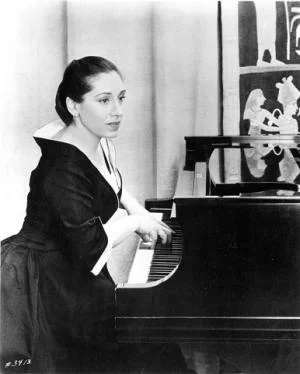 Concerto no. 2 with the Philadelphia Orchestra and earlier in her career played many concerts with a broad repertoire. All we could find for this occasion was her Carnegie Hall live recording of Beethoven’s Emperor concerto no. 5. It was radio broadcast on March 17th of 1940. On that occasion, Sir John Barbirolli conducted the New York Philharmonic Orchestra. Here are the second and third movements of the Concerto (we trimmed a very long ovation at the end).
Concerto no. 2 with the Philadelphia Orchestra and earlier in her career played many concerts with a broad repertoire. All we could find for this occasion was her Carnegie Hall live recording of Beethoven’s Emperor concerto no. 5. It was radio broadcast on March 17th of 1940. On that occasion, Sir John Barbirolli conducted the New York Philharmonic Orchestra. Here are the second and third movements of the Concerto (we trimmed a very long ovation at the end).
Ida Haendel was more of a surprise. We knew that Tureck specialized in Bach but we thought we’d find many Haendel recordings of Beethoven, considering that his 10 violin sonatas and the concerto are a staple of concert repertoires. That turned out tonot quite be the case. Haendel was 14 years younger than Tureck and also Jewish. She was born in Poland, but her family moved to Britain before WWII. Haendel was a real child prodigy. In 1935, at the age of seven, she participated in the first Henryk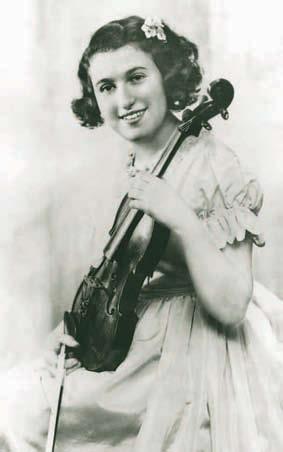 Wieniawski Violin Competition in Warsaw. It was a celebrated event, broadly covered by the European (and Soviet) press, and its results were surprising. The 16-year-old Ginette Neveu won the first prize, beating the already famous 29-year-old David Oistrakh, who took second. Another child prodigy, the 12-year-old Boris Goldstein took a rather disappointing fourth prize. But the greatest sensation was probably the performance of Ida, who took the 7th prize, ahead of scores of talented violinists. She went on to have a wonderful career and lived to the ripe age of 91, still performing into her eighties. She made a significant number of recordings, even though many of them were still mono. Among them are just two pieces by Beethoven, his Violin concerto and the Violin sonata no. 8. We know that she performed his other sonatas in concert, why she never recorded them is a mystery. Here’s a recording of Beethoven’s Violin Sonata no. 8 that Ida Haendel made in 1941. At that time she was 12 years old. Noel Mewton-Wood, then 18, is at the piano. (Mewton-Wood, a talented Australian-born British pianist, had a short life: in tragic circumstances he committed suicide at the age of 31.)Permalink
Wieniawski Violin Competition in Warsaw. It was a celebrated event, broadly covered by the European (and Soviet) press, and its results were surprising. The 16-year-old Ginette Neveu won the first prize, beating the already famous 29-year-old David Oistrakh, who took second. Another child prodigy, the 12-year-old Boris Goldstein took a rather disappointing fourth prize. But the greatest sensation was probably the performance of Ida, who took the 7th prize, ahead of scores of talented violinists. She went on to have a wonderful career and lived to the ripe age of 91, still performing into her eighties. She made a significant number of recordings, even though many of them were still mono. Among them are just two pieces by Beethoven, his Violin concerto and the Violin sonata no. 8. We know that she performed his other sonatas in concert, why she never recorded them is a mystery. Here’s a recording of Beethoven’s Violin Sonata no. 8 that Ida Haendel made in 1941. At that time she was 12 years old. Noel Mewton-Wood, then 18, is at the piano. (Mewton-Wood, a talented Australian-born British pianist, had a short life: in tragic circumstances he committed suicide at the age of 31.)Permalink
This Week in Classical Music: December 5, 2022. Ernst Toch. For the last several weeks we’ve been preoccupied with the music of Rome. It’s now time for us to get back to important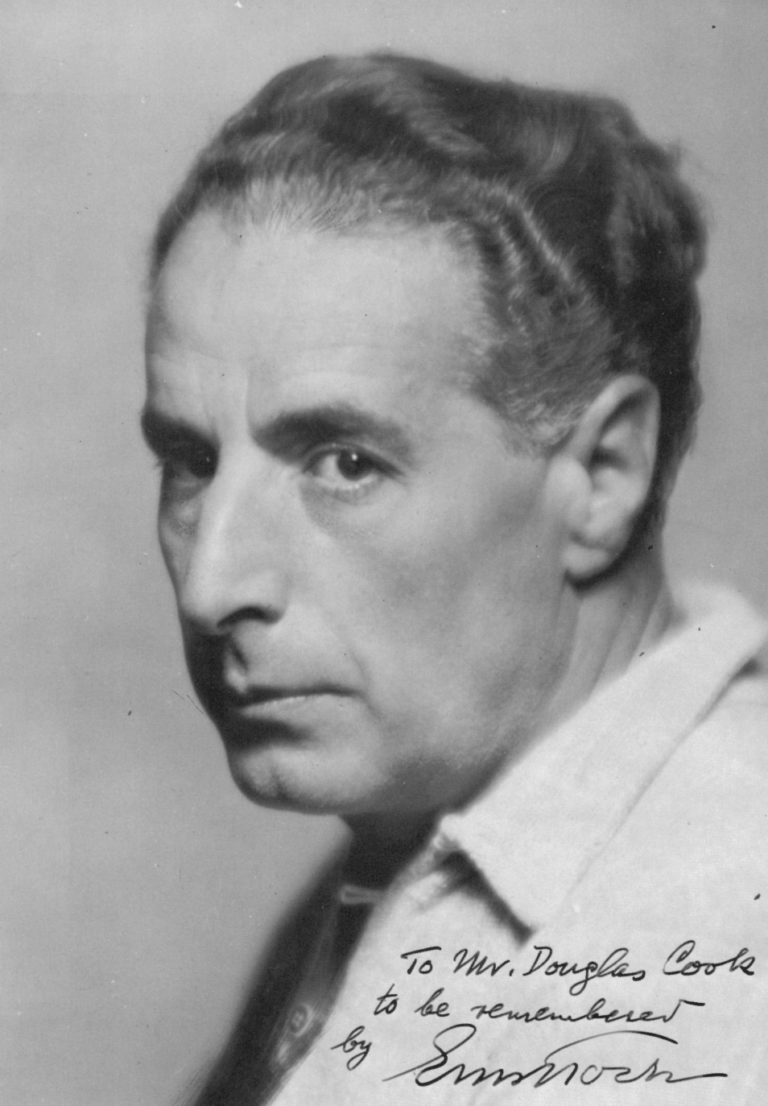 dates in the musical calendar. Today it’s about the composer who was very prominent early in the 20th century Europe but is practically forgotten these days, Ernst Toch. Toch was born on December 7th of 1887 in Leopoldstadt, the same poor Jewish district of Vienna where Arnold Schoenberg was born some 13 years earlier. Toch started composing early but for a while wasn’t sure what his real calling was: he studied philosophy and medicine at fine universities before turning to music full time. In 1909 his Quartet no. 6 was performed to great acclaim by the Rosé Quartet (the quartet, one of the best in Austria, was founded by Arnold Rosé, the longtime concertmaster of the Vienna Philharmonic Orchestra and Mahler’s brother-in-law). During WWI Toch served in the Austrian army in South Tyrol. The war affected him profoundly, and his post-war style changed from the late-Romantic to much edgier, sometimes atonal. Also at that time Toch moved from Austria to Mannheim, Germany. Here’s Toch’s Quartet no.9, from 1920, performed by the Verdi Quartet. And to compare, the lyrical Violin Sonata from the end of his early Romantic period; it’s performed by the violinist Annette von Hehn and the pianist Katya Apekisheva.
dates in the musical calendar. Today it’s about the composer who was very prominent early in the 20th century Europe but is practically forgotten these days, Ernst Toch. Toch was born on December 7th of 1887 in Leopoldstadt, the same poor Jewish district of Vienna where Arnold Schoenberg was born some 13 years earlier. Toch started composing early but for a while wasn’t sure what his real calling was: he studied philosophy and medicine at fine universities before turning to music full time. In 1909 his Quartet no. 6 was performed to great acclaim by the Rosé Quartet (the quartet, one of the best in Austria, was founded by Arnold Rosé, the longtime concertmaster of the Vienna Philharmonic Orchestra and Mahler’s brother-in-law). During WWI Toch served in the Austrian army in South Tyrol. The war affected him profoundly, and his post-war style changed from the late-Romantic to much edgier, sometimes atonal. Also at that time Toch moved from Austria to Mannheim, Germany. Here’s Toch’s Quartet no.9, from 1920, performed by the Verdi Quartet. And to compare, the lyrical Violin Sonata from the end of his early Romantic period; it’s performed by the violinist Annette von Hehn and the pianist Katya Apekisheva.
The 1920 were very productive for Toch: he composed two short operas, a Concerto for Cello, and several orchestral pieces. His works were regularly performed at the prestigious Donaueschingen Festival. All this ended in 1933 with Hitler coming to power. Toch, who was Jewish, moved to Paris, and from there to London. (An interesting aside concerning Toch’s stature in Germany at that time: he was in Florence in April and May of 1933 at the very first Maggio Musicale Festival, representing Germany along with Richard Strauss. From Florence he went to Paris, rather than returning to Germany). For a Jew, refugee life in Europe wasn’t easy, and in 1935 Toch moved to the US: he received a position at the New School for Social Research, or, as it was then known, the “University in Exile,” as many emigrees from Europe found jobs there. To support himself, he started writing music scores for movies, following the path of many exiled composers (Erich Wolfgang Korngold was the most successful of them), and eventually moved to California. All along he was trying to establish himself as a serious classical composer in the US – a position he rightfully held back in Europe. That didn’t work out, as the American public wasn’t very interested in his more modern compositions (though his film music was quite successful). After the war, Toch attempted to reestablish himself in Europe but that also didn’t work out: while “too radical” for the conservative late-1940s – early 1950s America, Toch wasn’t radical enough for the post-war Europe, where the likes of Stockhausen, Boulez and other composers of the Darmstadt school were gaining prominence. Eventually Toch reverted to teaching and composing symphonies, mostly in the late-Romantic style.
Here, from 1932, is Toch’s Piano Concerto, with Todd Crow at the piano and the NDR-Hamburg Symphony Orchestra under the direction of Leon Botstein.Permalink
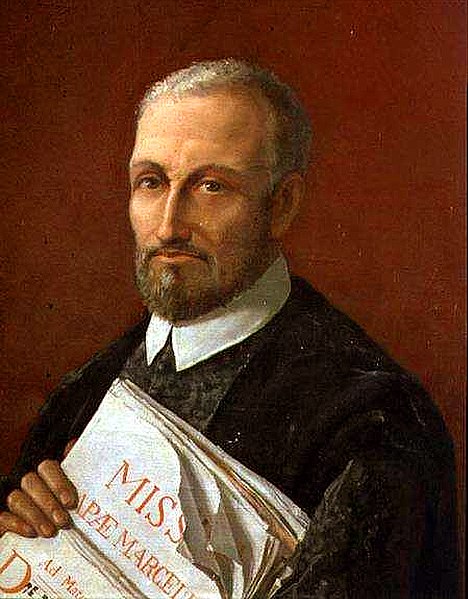 historically and made it all the way to one of the greatest composers of the Renaissance, Giovanni Pierluigi da Palestrina. Palestrina, born in 1525, was not only a supremely talented composer, he also lived during a period of profound social and religious changes. The major one was the Reformation, which started in 1517 with Martin Luther publishing his 95 theses. By the time of Palestrina, it was in full swing and profoundly affecting the Catholic church. Another one was the Sack of Rome. It happened two years after Palestrina’s birth, in 1527, when Rome was pillaged by the renegade soldiers of the Emperor Charles V. As a result, the population of the city fell from 55,000 to just 10,000 (it would grow to about 100,000 by the end of the 16th century). In 1537, aged 12, Palestrina came to Rome and sung in the choir of the Basilica of Santa Maria Maggiore. He then returned to his native town of Palestrina but three years later, in 1540, moved back to Rome, this time to settle for the rest of his life. In 1551, Pope Julius III, who in his earlier life was the bishop of Palestrina, appointed him maestro di cappella of the Cappella Giulia, the second, after Capella Sistina, most important choir in the Vatican. During his life Palestrina held several major musical positions, serving as the maestro di cappella in the papal basilica of San Giovanni in Laterano, in Santa Maria Maggiore, and later in his life, back to Capella Giulia. His first book of masses was published in 1554 and soon after he established himself as the most significant Italian composer of his generation.
historically and made it all the way to one of the greatest composers of the Renaissance, Giovanni Pierluigi da Palestrina. Palestrina, born in 1525, was not only a supremely talented composer, he also lived during a period of profound social and religious changes. The major one was the Reformation, which started in 1517 with Martin Luther publishing his 95 theses. By the time of Palestrina, it was in full swing and profoundly affecting the Catholic church. Another one was the Sack of Rome. It happened two years after Palestrina’s birth, in 1527, when Rome was pillaged by the renegade soldiers of the Emperor Charles V. As a result, the population of the city fell from 55,000 to just 10,000 (it would grow to about 100,000 by the end of the 16th century). In 1537, aged 12, Palestrina came to Rome and sung in the choir of the Basilica of Santa Maria Maggiore. He then returned to his native town of Palestrina but three years later, in 1540, moved back to Rome, this time to settle for the rest of his life. In 1551, Pope Julius III, who in his earlier life was the bishop of Palestrina, appointed him maestro di cappella of the Cappella Giulia, the second, after Capella Sistina, most important choir in the Vatican. During his life Palestrina held several major musical positions, serving as the maestro di cappella in the papal basilica of San Giovanni in Laterano, in Santa Maria Maggiore, and later in his life, back to Capella Giulia. His first book of masses was published in 1554 and soon after he established himself as the most significant Italian composer of his generation.
This Week in Classical Music: November 28, 2022. Rome, yet again (Palestrina). In our previous entry, while discussing composers who had worked in Rome, we were moving
The Council of Trent was called by Pope Paul III in response to the Reformation and lasted from 1545 to 1563. While the most important decision made by the bishops were doctrinal and liturgical, it affected church music as well. Two most important changes were as follows: secular themes for the music were prohibited, as many of the so-called “parody masses” written prior to that were based on secular songs, some with quite provocative lyrics. And the second one had to do with comprehension of the text: the words of the masses had to be understandable.. That was a high order for the polyphonic style of masses, where different voices were sung in different rhythm and different registers. That often made the text practically incomprehensible. Palestrina is often considered the “savior” of the polyphonic mass: his Missa Papae Marcelli convinced Carlo Borromeo, one of the leading counter-Reformation cardinals, that the words of a polyphonic mass can be intelligible. Here are Sanctus and Benedictus from Missa Papae Marcelli, performed by the Tallis Scholars.
Palestrina wrote more than 100 masses and many more madrigals and motets. He was considered the ideal Catholic composer and his fame spread all over Europe, even to the Protestant countries. We have several pieces by Palestrina in our library and here are two of them. First, the Kyrie section of his mass Benedictus Es, published in 1593. As the recording of Missa Papae Marcelli, It’s performed by the Tallis Scholars. And here, performed by the same ensemble, is Palestrina’s Missa Nigra Sum. The whole mass runs for about 35 minutes. We think it’s worth your time.Permalink
This Week in Classical Music: November 21, 2022. Rome again. Even though there are many significant anniversaries this week (composers Wilhelm Friedemann Bach, Benjamin Britten,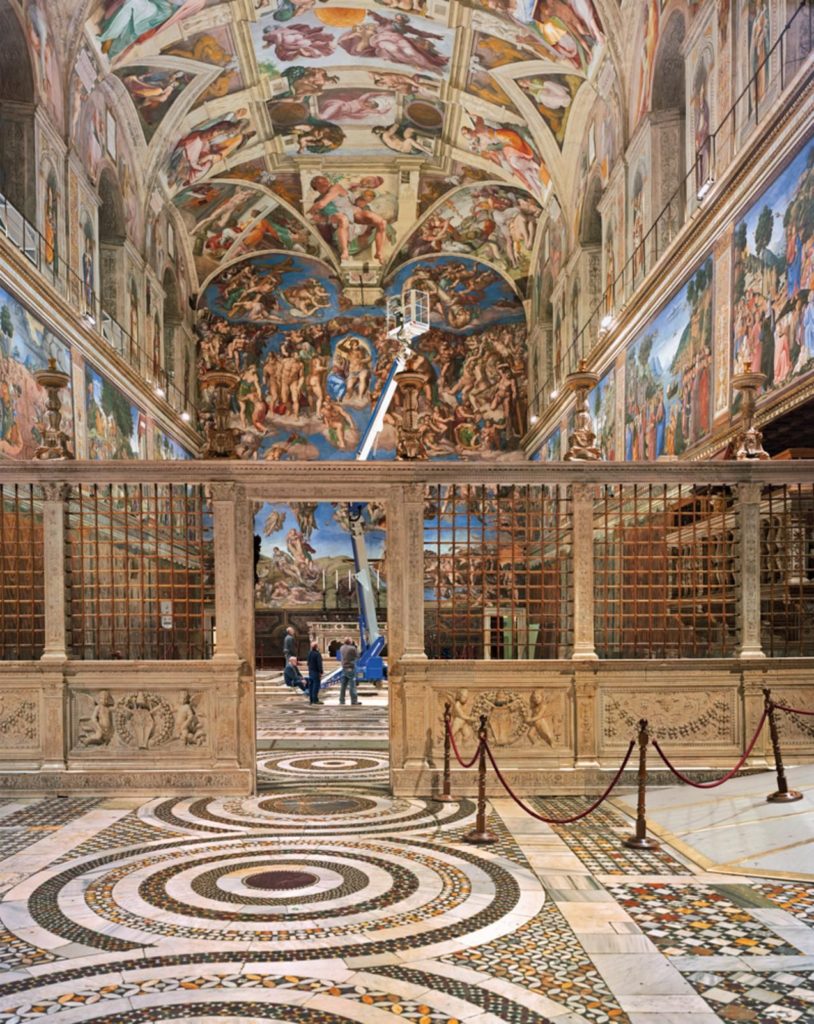 Manuel de Falla, Krzysztof Penderecki, and Alfred Schnittke, the pianists Wilhelm Kempff and Earl Wild, the violinist Hilary Hahn, the tenor Alfredo Kraus among them) we’ll return to Rome. Rome was central to the musical life of Europe for centuries, and it couldn’t have been otherwise: much of the music was written for religious services, while Rome was the place of papacy, the spiritual center of the Western world till the Reformation and to a considerable extent even later. It was especially so when polyphony was the predominant style in which church music, mass in particular, was written. Even though Rome was not the place where the first significant and identifiable European musical school had appeared – that was the Flanders and France (Belgium and Northern France now), where the Franco-Flemish school originated – many of the important composers traveled to Rome and served at the papal court. And why wouldn’t they if popes were rich patrons and the papal choir was considered the best in Europe? The choir had a long history, going back all the way to Scuola Cantorum, instituted by Pope Sylvester I in the fourth (!) century. It was reorganized by Pope Gregory I the Great (a great pope but not the inventor of the Gregorian chant which was a later creation). By the time of the
Manuel de Falla, Krzysztof Penderecki, and Alfred Schnittke, the pianists Wilhelm Kempff and Earl Wild, the violinist Hilary Hahn, the tenor Alfredo Kraus among them) we’ll return to Rome. Rome was central to the musical life of Europe for centuries, and it couldn’t have been otherwise: much of the music was written for religious services, while Rome was the place of papacy, the spiritual center of the Western world till the Reformation and to a considerable extent even later. It was especially so when polyphony was the predominant style in which church music, mass in particular, was written. Even though Rome was not the place where the first significant and identifiable European musical school had appeared – that was the Flanders and France (Belgium and Northern France now), where the Franco-Flemish school originated – many of the important composers traveled to Rome and served at the papal court. And why wouldn’t they if popes were rich patrons and the papal choir was considered the best in Europe? The choir had a long history, going back all the way to Scuola Cantorum, instituted by Pope Sylvester I in the fourth (!) century. It was reorganized by Pope Gregory I the Great (a great pope but not the inventor of the Gregorian chant which was a later creation). By the time of the 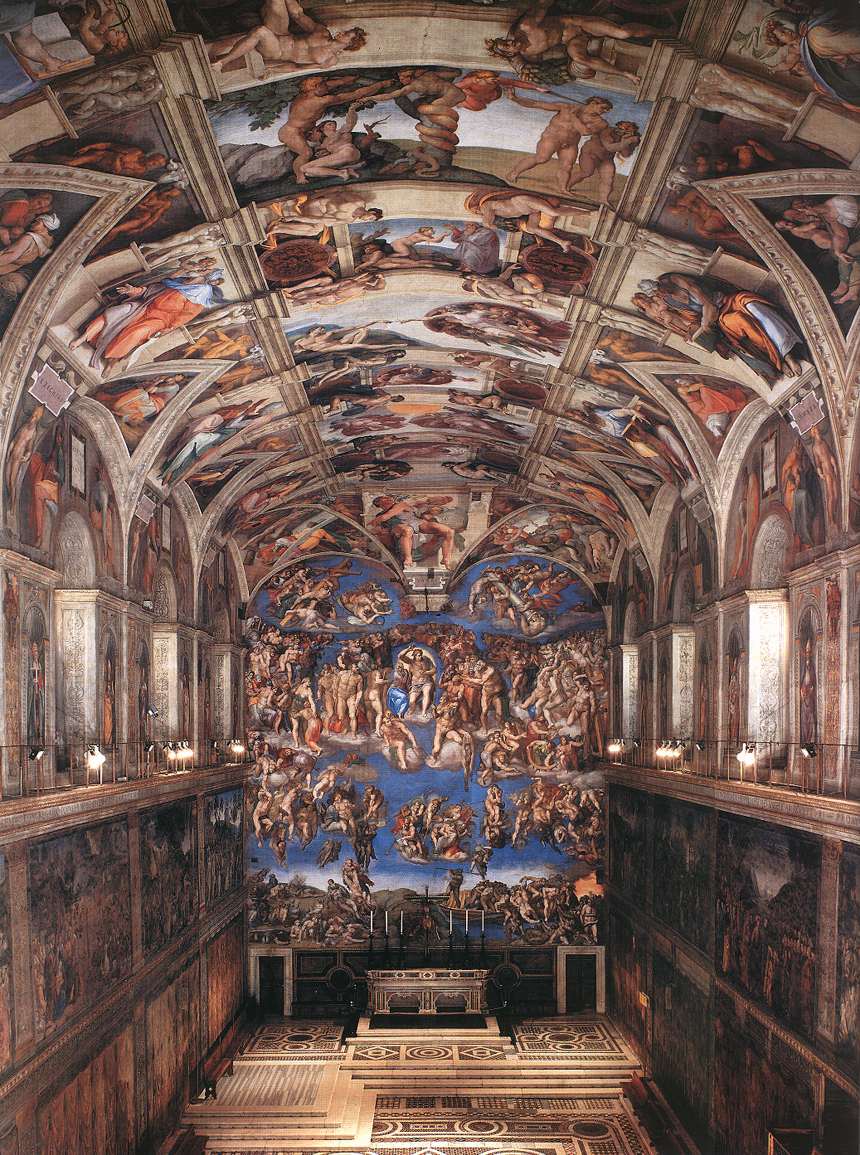 Renaissance, it was the private choir of the powerful popes and in 1470 it got a magnificent new home in the chapel built by Pope Sixtus IV, first called Capella Magna and then by the name we all know, the Sistine Chapel. Officially called Coro della Cappella Musicale Pontificia Sistina, it was acknowledged as the best musical ensemble in all of Europe.
Renaissance, it was the private choir of the powerful popes and in 1470 it got a magnificent new home in the chapel built by Pope Sixtus IV, first called Capella Magna and then by the name we all know, the Sistine Chapel. Officially called Coro della Cappella Musicale Pontificia Sistina, it was acknowledged as the best musical ensemble in all of Europe.
Guillaume Dufay, born around Brussels in 1397, was one of the first and probably most influential composers of the early Renaissance. He moved to Rome in 1428, became a member of the papal choir and, while there, wrote several motets and masses. Josquin des Prez, probably the greatest composer of the next period, was born around 1450 in the French-speaking part of the Low Countries; he came to Rome in 1489 and became the composer and music director of the Capella for the next five years. Some of the greatest composers of the younger generations followed suit. Jacob Arcadelt (born in 1507 and better known for his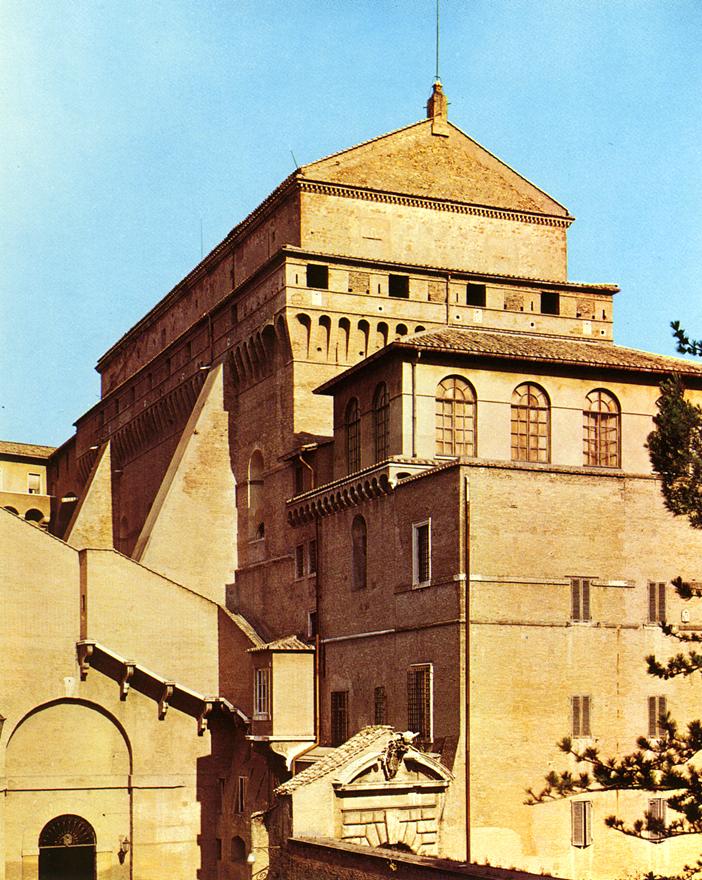 secular madrigals), moved to Rome in 1538 and sung in the Capella for several years. Orlando di Lasso, one of the geniuses of the High Renaissance (he was born in 1532), was employed as maestro di cappella at the Basilica of San Giovanni in Laterano, for centuries, till the new St. Peter’s Basilica was built, the most important church of Rome. Giaches De Wert (born in 1535), another influential composer, spent much time in Ferrara but also found work in Rome. But if there was a composer most closely associated with Rome, that would clearly be Giovanni Pierluigi da Palestrina. Palestrina, the Council of Trent and some composers that came up later – all that we’ll address in a subsequent entry. In the meantime, some music from Rome. By Guillaume Dufay, a motet Apostolo glorioso. By Josquin des Prez, also a motet, but for 24 voices Qui habitat. By Jacob Arcadelt, another motet, a beautiful Ave Maria. From Orlando di Lasso, one of the motets from Prophecies of the Sibyls. By Giaches De Wert, a madrigal Misera, che faro. And from the talented Luca Marenzio (1553-1599), who also spent most of his career in Rome, another madrigal, Madonna, sua mercé. Permalink
secular madrigals), moved to Rome in 1538 and sung in the Capella for several years. Orlando di Lasso, one of the geniuses of the High Renaissance (he was born in 1532), was employed as maestro di cappella at the Basilica of San Giovanni in Laterano, for centuries, till the new St. Peter’s Basilica was built, the most important church of Rome. Giaches De Wert (born in 1535), another influential composer, spent much time in Ferrara but also found work in Rome. But if there was a composer most closely associated with Rome, that would clearly be Giovanni Pierluigi da Palestrina. Palestrina, the Council of Trent and some composers that came up later – all that we’ll address in a subsequent entry. In the meantime, some music from Rome. By Guillaume Dufay, a motet Apostolo glorioso. By Josquin des Prez, also a motet, but for 24 voices Qui habitat. By Jacob Arcadelt, another motet, a beautiful Ave Maria. From Orlando di Lasso, one of the motets from Prophecies of the Sibyls. By Giaches De Wert, a madrigal Misera, che faro. And from the talented Luca Marenzio (1553-1599), who also spent most of his career in Rome, another madrigal, Madonna, sua mercé. Permalink
This Week in Classical Music: November 14, 2022. Rome. On one of our recent walks in Rome, while coming down the Janiculum Hill (the Belvedere at the top offers a magnificent view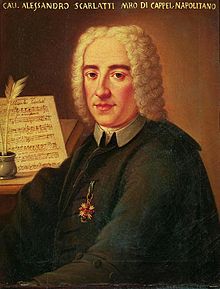 of the city), we came across a sign on a gate, Accademia degli Arcadi. The gate was closed and led, it seemed, into the gardens. That was puzzling: could it be the Academy? Wasn’t it dissolved many years ago? We had to investigate, and the answers were surprising – but first let’s look back at what Accademia degli Arcadi was about and when. The beginnings of the Academy go back to the time of Queen Christina of Sweden’s sojourn to Rome. Christina, who abdicated the Swedish throne in 1654 but kept much of her riches, converted to Catholicism, settled in Rome in the Palazzo Farnese and surrounded herself with the most illustrious Roman intellectuals – poets, composers, philosophers. She became a patron to many of them. On January 24th of 1656 she opened an Academy, providing a space in the Palazzo Farnese, and called it Accademia degli Arcadi; it was a society devoted to cultural and intellectual affairs; its member met to discuss matters they deemed important, whether in poetry, music or arts. Much of it in those days was directed against the predominant Baroque style.
of the city), we came across a sign on a gate, Accademia degli Arcadi. The gate was closed and led, it seemed, into the gardens. That was puzzling: could it be the Academy? Wasn’t it dissolved many years ago? We had to investigate, and the answers were surprising – but first let’s look back at what Accademia degli Arcadi was about and when. The beginnings of the Academy go back to the time of Queen Christina of Sweden’s sojourn to Rome. Christina, who abdicated the Swedish throne in 1654 but kept much of her riches, converted to Catholicism, settled in Rome in the Palazzo Farnese and surrounded herself with the most illustrious Roman intellectuals – poets, composers, philosophers. She became a patron to many of them. On January 24th of 1656 she opened an Academy, providing a space in the Palazzo Farnese, and called it Accademia degli Arcadi; it was a society devoted to cultural and intellectual affairs; its member met to discuss matters they deemed important, whether in poetry, music or arts. Much of it in those days was directed against the predominant Baroque style.
After Christina’s death in 1689 the Academy had to move several times and, in 1723, thanks to the generosity of King John V of Portugal, it settled in a newly built villa in a garden on the slope of the Janiculum, called Bosco Parrasio. The gate leading to the villa was what we saw on our walk down the hill. The Academy functioned as an important cultural institution for many years but with time it became less relevant, and, by the end of the 19th century, quite conservative. It still exists to this day, but instead of being a place where new ideas are generated and new arts promoted, it became a research institution, branching into such fields as history and archeology. It also moved, and Bosco Parrasio stays mostly empty, though some concerts are being played there occasionally. The Academy’s new headquarters are located not far from Piazza Navona, in the Biblioteca Angelica on Piazza di S. Agosino.
During the Academy’s early, and most vigorous, days, many prominent composers were its members, among them Alessandro Scarlatti, Arcangelo Corelli, Giovanni Bononcini, and brothers Alessandro and Benedetto Marcello. The famous opera librettist Pietro Metastasio also was a member. The young Handel, while he lived in Rome, attended its meetings. Let’s hear some of the music created by the Arcadians. Alessandro Scarlatti was famous for his operas, but he also wrote some church music. Here’s Credo, from his Messa di Santa Cecilia. Maurice Abravanel leads the Utah Symphony Orchestra and the University of Utah Chorus. Giuseppe Valentini, another Arcadian, was born in 1681; he is not as well-known as Scarlatti but his Concerto in A minor, op. 7, no. 11 is delightful. Here it is, in the performance by the Musica Antiqua Köln.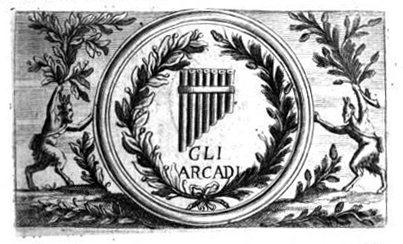
Permalink
This Week in Classical Music: November 7, 2022. Brief Italian entry 2. We’re still under the Italian spell, but this week it’s harder to maintain the Italian theme: we have only one Italian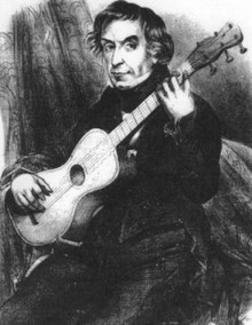 composer, and, unfortunately, rather mediocre – Luigi Legnani, born on November 7th of 1790 in Ferrara. He started as a tenor but switched to playing the guitar when he was almost 30. He turned out to be very good at that: after making a name for himself in Italy, he went to Vienna in 1822 and performed there to great acclaim. Critics calling him a worthy successor to Mauro Giuliani, another Italian, a virtuoso guitar player and composer, who spent many years in Vienna, built a highly successful career and made friends with Beethoven, Rossini and members of the Imperial court. Legnani toured many European countries and at some point, met Paganini, himself an excellent guitar player. They became friendly and even planned a concert together but at the last moment Paganini got sick. Legnani composed about 250 works, most of them for the guitar. Later in life he settled in Ravenna where he built fine guitars and violins. Here is Luigi Legnani's Capriccio no. 28, op. 20, played by the Italian guitarist Federica Canta.
composer, and, unfortunately, rather mediocre – Luigi Legnani, born on November 7th of 1790 in Ferrara. He started as a tenor but switched to playing the guitar when he was almost 30. He turned out to be very good at that: after making a name for himself in Italy, he went to Vienna in 1822 and performed there to great acclaim. Critics calling him a worthy successor to Mauro Giuliani, another Italian, a virtuoso guitar player and composer, who spent many years in Vienna, built a highly successful career and made friends with Beethoven, Rossini and members of the Imperial court. Legnani toured many European countries and at some point, met Paganini, himself an excellent guitar player. They became friendly and even planned a concert together but at the last moment Paganini got sick. Legnani composed about 250 works, most of them for the guitar. Later in life he settled in Ravenna where he built fine guitars and violins. Here is Luigi Legnani's Capriccio no. 28, op. 20, played by the Italian guitarist Federica Canta.
Our second Italian, Giuseppe Sinopoli, was a very talented (and unorthodox) conductor and composer. Born on November 2nd of 1946 in Venice, he studied with Bruno Maderna, one of most prominent Italian modernist composers, and later with Karlheinz Stockhausen in Darmstadt. In 1975 Sinopoli formed the Bruno Maderna Ensemble to perform contemporary music; in 1978 he conducted his first opera, Aida, in Venice. During that period, he composed an opera, Lou Salomé, which was staged in Munich in 1981. He later dropped composing and devoted himself to conducting. Sinopoli’s career developed rapidly: in 1983 he became the Chief conductor of the Academy of Santa Cecilia in Rome, went on to conduct the New York Philharmonic and Philharmonia Orchestra from London, worked at the Bayreuth Festival. In 1990 he was appointed to the prestigious position of music director at the Berlin Deutsche Oper but didn’t take it, moving instead to Dresden’s Staatskapelle as their principal conductor. Sinopoli died on April 20th of 2001 of a heart attack while conducting the third act of Aida at the Deutsche Oper. Here’s Giuseppe Sinopoli conducting the Staatskapelle Dresden orchestra in the first movement of Bruckner’s Symphony no. 5.Permalink